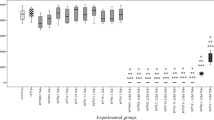Abstract
The aim of the present study is to evaluate the antimicrobial effect of photodynamic therapy (PDT) using a highly pure chlorin e6 (Ce6), against various pathogenic bacteria. To examine the antimicrobial effect of Ce6-mediated PDT against Staphylococcus aureus, Pseudomonas aeruginosa, Escherichia coli, and Salmonella enterica serovar Typhimurium, inhibition zone formation, CFU quantification, and bacterial viability were evaluated. Inhibition zone analysis showed that Ce6-mediated PDT is very effective to inhibit the growth of S. aureus and P. aeruginosa, but has only minor effect to E. coli and S. Typhimurium, which was dependent on the energy density of laser and dose of Ce6. Ce6-mediated PDT also nearly inhibited the colony formation of S. aureus and P. aeruginosa, and partially inhibited that of E. coli and S. Typhimurium. In addition, the number of viable bacteria decreased greatly after PDT application with LS-chlorin e6 of 10 μM and laser and energy density of 20 J/cm2. These results show that Ce6-mediated PDT can be an effective alternative for antimicrobial treatment.



Similar content being viewed by others
References
Seal JB, Moreira B, Bethel CD, Daum RS (2003) Antimicrobial resistance in Staphylococcus aureus at the University of Chicago Hospitals: a 15-year longitudinal assessment in a large university-based hospital. Infect Control Hosp Epidemiol 24:403–408
Cerveny KE, DePaola A, Duckworth DH, Gulig PA (2002) Phage therapy of local and systemic disease caused by Vibrio vulnificus in iron-dextran-treated mice. Infect Immun 70:6251–6262
Sajjan US, Tran LT, Sole N, Rovaldi C, Akiyama A, Friden PM, Forstner JF, Rothstein DM (2001) P-113D, an antimicrobial peptide active against Pseudomonas aeruginosa, retains activity in the presence of sputum from cystic fibrosis patients. Antimicrob Agents Chemother 45:3437–3444
Wainwright M (1998) Photodynamic antimicrobial chemotherapy (PACT). J Antimicrob Chemother 42:13–28
Kossodo S, LaMuraglia GM (2001) Clinical potential of photodynamic therapy in cardiovascular disorders. Am J Cardiovasc Drugs 1:15–21
Ahmad S, Bearelly S, Stinnett SS, Cooney MJ, Fekrat S (2008) Photodynamic therapy for predominantly hemorrhagic lesions in neovascular age-related macular degeneration. Am J Ophthalmol 145:1052–1057
Sibata CH, Colussi VC, Oleinick NL, Kinsella TJ (2001) Photodynamic therapy in oncology. Expert Opin Pharmacother 2:917–927
Silva JN, Filipe P, Morliere P, Maziere JC, Freitas JP, Gomes MM, Santus R (2008) Photodynamic therapy: dermatology and ophthalmology as main fields of current applications in clinic. Biomed Mater Eng 18:319–327
Trauner KB, Hasan T (1996) Photodynamic treatment of rheumatoid and inflammatory arthritis. Photochem Photobiol 64:740–750
Phoenix DA, Sayed Z, Hussain S, Harris F, Wainwright M (2003) The phototoxicity of phenothiazinium derivatives against Escherichia coli and Staphylococcus aureus. FEMS Immunol Med Microbiol 39:17–22
Hamblin MR, Hasan T (2004) Photodynamic therapy a new antimicrobial approach to infectious disease? Photochem Photobiol Sci 3:436–450
Peloi LS, Soares RR, Biondo CE, Souza VR, Hioka N, Kimura E (2008) Photodynamic effect of light-emitting diode light on cell growth inhibition induced by methylene blue. J Biosci 33:231–237
Kostenich GA, Zhuravkin IN, Zhavrid EA (1994) Experimental grounds for using chlorin e6 in the photodynamic therapy of malignant tumors. J Photochem Photobiol B 22:211–217
Moon YH, Kwon SM, Kim HJ, Jung KY, Park JH, Kim SA, Kim YC, Ahn SG, Yoon JH (2009) Efficient preparation of highly pure chlorin e6 and its photodynamic anti-cancer activity in rat tumor model. Oncol Rep 22:1085–1091
Demidova TN, Gad F, Zahra T, Francis KP, Hamblin MR (2005) Monitoring photodynamic therapy of localized infections by bioluminescence imaging of genetically engineered bacteria. J Photochem Photobiol B 81:15–25
Malik ZA, Broughel D (2007) The importance of testing whole stool for Shiga toxin: a clinical and microbiological perspective. J Pak Med Assoc 57:265–266
Tegos GP, Anbe M, Yang C, Demidova TN, Satti M, Mroz P, Janjua S, Gad F, Hamblin MR (2006) Proteae-stable polycationic photosensitizer conjugates between polyethyleneimine and chlorin(e6) for broad-spectrum antimicrobial photoinactivation. Antimicrob Agents Chemother 50:1402–1410
Hamblin MR, O’Donnell DA, Murthy N, Rajagopalan K, Michaud N, Sherwood ME, Hasan T (2002) Polycationic photosensitizer conjugates: effects of chain length and Gram classification on the photodynamic inactivation of bacteria. J Antimicrob Chemother 49:941–951
Malik Z, Hanania J, Nitzan Y (1990) Bactericidal effects of photoactivated porphyrins—an alternative approach to antimicrobial drugs. J Photochem Photobiol B 5:281–293
Bertoloni G, Salvato B, Dall’Acqua M, Vazzoler M, Jori G (1984) Hematoporphyrin-sensitized photoinactivation of Streptococcus faecalis. Photochem Photobiol 39:811–816
Nitzan Y, Gutterman M, Malik Z, Ehrenberg B (1992) Inactivation of Gram-negative bacteria by photosensitized porphyrins. Photochem Photobiol 55:89–96
Jori G, Fabris C, Soncin M, Ferro S, Coppellotti O, Dei D, Fantetti L, Chiti G, Roncucci G (2006) Photodynamic therapy in the treatment of microbial infections: basic principles and perspective applications. Laser Sur Med 38:468–481
Acknowledgements
This study was supported by a grant from the Korea Healthcare Technology R&D Project, Ministry for Health, Welfare & Family Affairs, Republic of Korea (A080160).
Author information
Authors and Affiliations
Corresponding authors
Rights and permissions
About this article
Cite this article
Park, JH., Moon, YH., Bang, IS. et al. Antimicrobial effect of photodynamic therapy using a highly pure chlorin e6. Lasers Med Sci 25, 705–710 (2010). https://doi.org/10.1007/s10103-010-0781-1
Received:
Accepted:
Published:
Issue Date:
DOI: https://doi.org/10.1007/s10103-010-0781-1




